Dell Latitude E6410: Minding Intel's Business
by Jarred Walton on December 2, 2010 2:45 AM ESTPerformance: Intel's Outgoing Calpella Platform
Okay, we've set the stage for the performance metrics, and again it's important to note that we are intentionally reviewing a bog-standard Dell Arrandale/Calpella platform. Intel wanted us to have a reference point for a good Arrandale setup for the arrival of Sandy Bridge, and that meant sticking with the Intel IGP and CPU. It's not a bad combination, but if Anand's desktop Sandy Bridge preview is any indication, we're about to see some significant increases in both CPU and GPU performance, all without dramatically affecting battery life—and if we're lucky, battery life might even improve. But let's not get ahead of ourselves; let's see how the E6410 stacks up in application performance and battery life. Note that the performance section of this review will focus more on Intel rather than Dell; if we were recommending the E6410, we'd likely opt for the FastTrack version with Quadro NVS 3100.
We've highlighted the Dell XPS 15, Apple MBP 13, and Acer 5551G as points of comparison for our current "best" mainstream notebook, the top Core 2 IGP combination, and a representative of AMD's performance (respectively). The Toshiba A660D is also slightly highlighted as a sample of AMD's switchable graphics platform. With a discrete GPU the Acer 5551G is obviously going to blow away anything with Intel IGP in graphics applications; the flipside is that it will hurt in battery life tests. Is it fair to compare something like the 5551G with the E6410? As a direct comparison, no: the E6410 is a business laptop with substantially better build quality and features. However, if we're just looking at performance, the E6410 is representative of the current Arrandale landscape as a whole, and pricing on basic Arrandale laptops is quite similar to that of the 5551G—the Acer TravelMate TM5742 for instance checks in at $610. On to the charts….
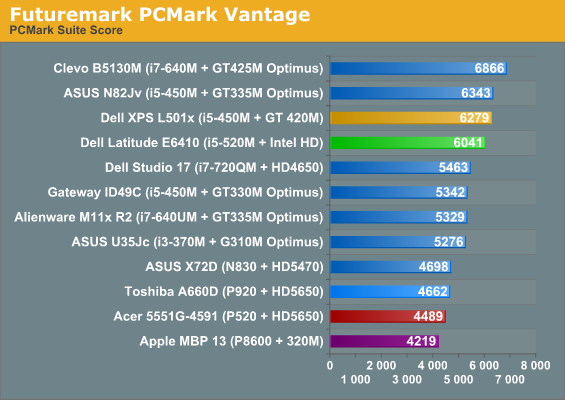
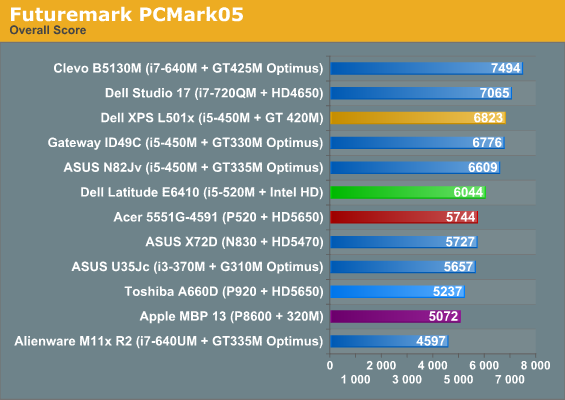
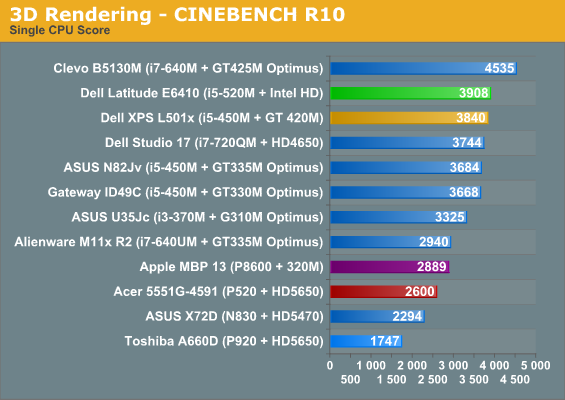
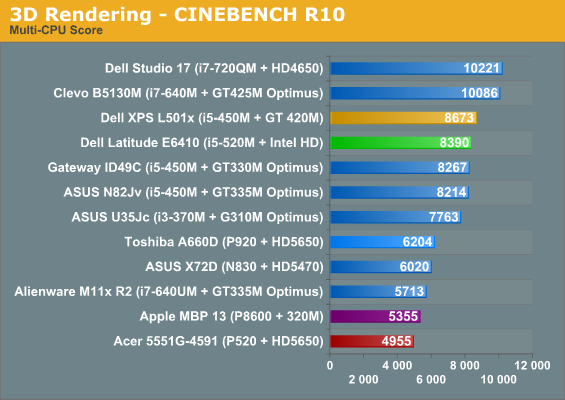
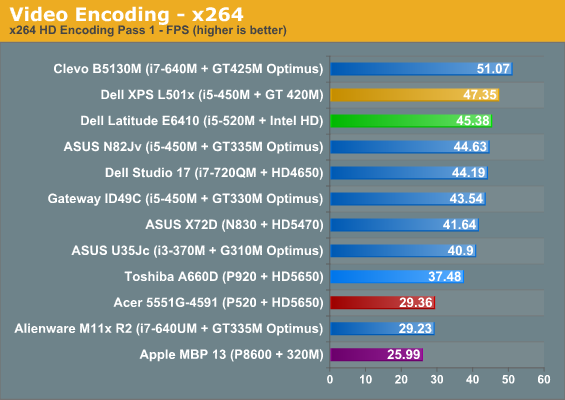
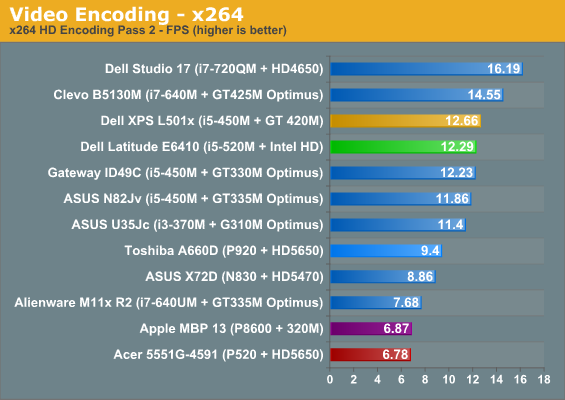
Starting with our application tests, the E6410 falls in the upper-middle of the PCMark charts and is usually in the top three or four slots for CPU centric tasks like Cinebench and x264 encoding. The i5-520M may not be the fastest Arrandale chip on the block, but it's definitely fast enough for all but the most demanding applications. It does fall behind the i5-450M in the XPS 15 in some tests, but PCMark05 lets the GPU skew the results quite a bit. That's not entirely unfair, of course, since the GPU can do a lot more than just 3D gaming. The three AMD laptops fall near the bottom of the charts, which merely illustrates once more that AMD's current K10.5 CPUs are ripe for replacement. The old Core 2 platform with NVIDIA 320M IGP, represented by the MacBook Pro 13, also checks in near the bottom of the application performance charts.
Next, let's throw out the 3DMark scores just as a point of reference for graphics horsepower. We'll include the older 3DMark versions this time, since IGPs are a better fit for the 03/05 iterations.
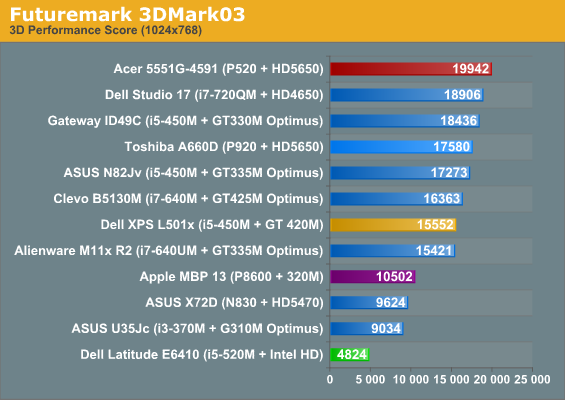
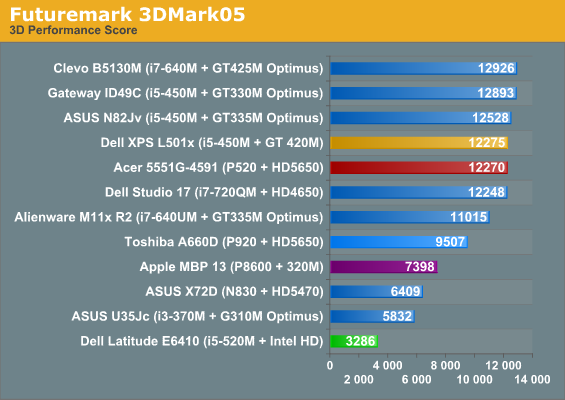
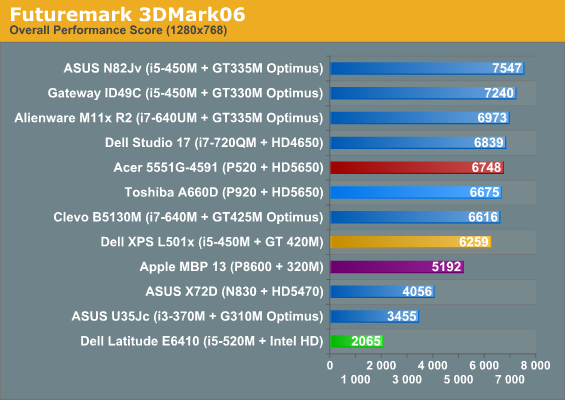
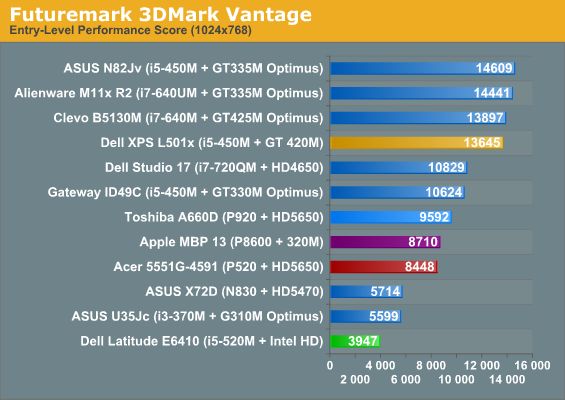
Here the discrete GPUs in the AMD systems make a good showing. We've mentioned in quite a few reviews that graphics benefits far more from a fast GPU than from a fast CPU, and while 3DMark isn't an actual game it definitely supports that point. The MBP 13 has an IGP that's more than twice as fast as the Intel HD Graphics, and depending on which 3DMark you look at the 5551G can nearly double the 320M. As long as you have a moderately fast CPU, you can easily go as high as HD 5650/GT 435M and in most cases the GPU will be what holds you back. As a last point of comparison, let's bring in the battery life figures.
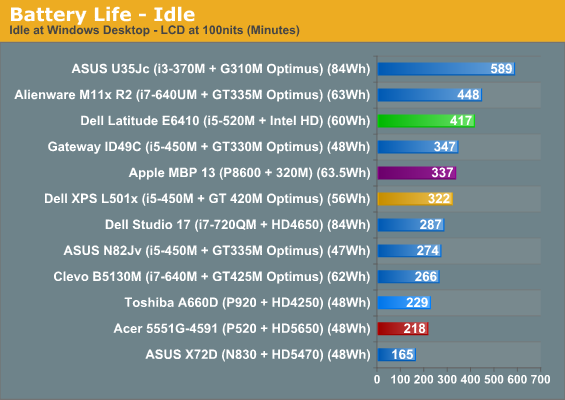
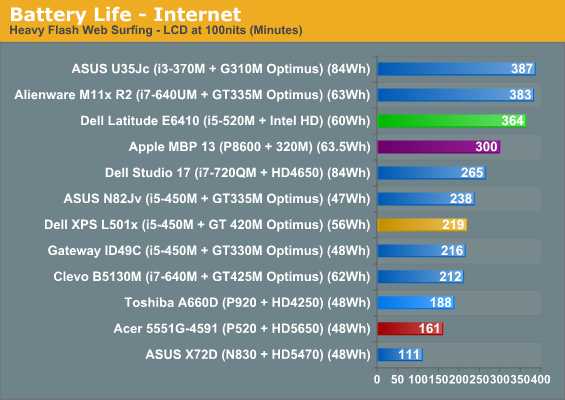
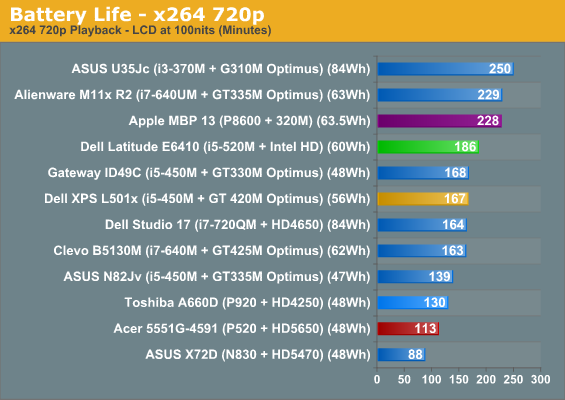
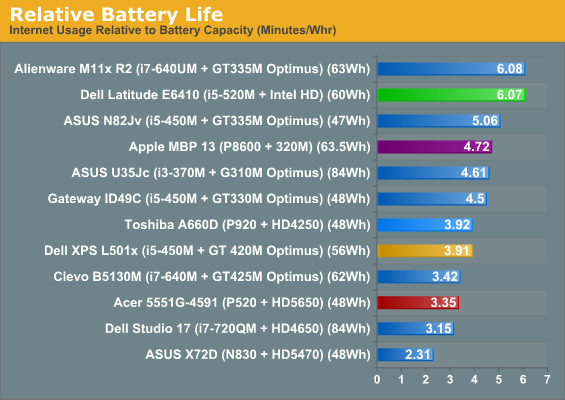
Intel's CPU+IGP may not impress as far as graphics performance, but it does manage to deliver very good battery life. Apple's MBP 13 is obviously handicapped by running Windows 7, but we're at least on a level playing field. For pure battery life, only the M11x R2 with ULV CPU (and a slightly larger battery) and the U35Jc (with a much larger battery) consistently top the E6410. Dell does have some good power management features, so the E6410 is probably about as good a representative of Intel's ideal battery life as we can find. While the IGP is behind the AMD and NVIDIA graphics solutions in terms of performance, it allows for much better battery life—perfect for a business laptop that isn't meant to play games.
If we look at relative battery life (i.e. factoring in battery capacity), the E6410 is right next to the U35Jc (6.95 vs. 7.01) and only slightly behind the M11x and ID49C in the idle figures (sorry, no chart for that data). The relative Internet battery life puts the E6410 in second place, bested only by the M11x and then only by a fraction of a percent. The only test where Intel's IGP appears to fall short is in x264 playback. (We use an x264 720p file, but the results should be representative of viewing most other H.264 video formats). The Gateway ID49C, M11x, and MBP 13 all surpass the E6410 and deliver 13-16% better relative battery life than the E6410 (again, no chart on this one). Still, three hours of H.264 video playback (provided you're not spinning a Blu-ray drive to get that content!) is quite good, and you could always upgrade to Dell's 9-cell battery if you need more.










51 Comments
View All Comments
G-Man - Thursday, December 2, 2010 - link
Hey Jarred,thanks for your review. If I may, I have a question: How do you normally decide on what laptops to review? I'm guessing you have to prioitise, so is there a consensus that you mostly review laptops that are either equipped with new technology (like the first optimus laptops) or laptops that you somehow know are going to be highly recommended (like the recent XPS 15)?
Also, are there any plans on reviewing Vostro? I recently bought a Vostro 3500 with core i3 and 2gb ram for something around the equivalent of $ 400, which I thought was pretty nice.
JarredWalton - Thursday, December 2, 2010 - link
Mostly, it's whatever we can get our hands on. ASUS is generally willing to send out their latest and greatest, as is Dell, but even they tend to be selective. If they don't think we're likely to give a reasonably favorable review, they're less likely to send a unit our way. At least, that's my experience after three years of laptop reviews.In this particular instance, Intel wanted to make sure I had an "Intel reference laptop" for times when I might want to compare, say, AMD IGP vs. Intel IGP, or old Intel vs. new Intel. So when they asked if I was interested, naturally I said sure. They offered a ThinkPad but as I mentioned, I wanted to play with a Latitude just as a change of pace. This review was obviously lower priority... basically, get it done before Sandy Bridge ships. Dell was also a little concerned with the review, as it's not what they'd deem their "best foot forward".
If I have the luxury of getting numerous laptops, I also try to prioritize on the stuff I think people will want to read/buy. A new technology is more interesting than "yet another standard Arrandale laptop". In the case of the XPS 15, I moved that ahead of a couple other laptops I've had longer (like this Latitude and the Acer 5551G). Toss in Dustin and Vivek and we get a fair selection of laptops reviewed all told. Now if only we could get Sony and HP to send us more stuff... Dustin has the Envy 17 now, but we're about three months late on that one. :-\
QChronoD - Thursday, December 2, 2010 - link
Is there somewhere on the site that we can send in suggestions for reviews/stories that we'd like to see? If you had several things in the backlog, maybe have us vote on which we'd be more interested in...On that note, please bug ASUS to send you guys one of the new U36's as soon as they can. From the press release, it looks like it'll be a direct competitor to the Air, only with a much faster cpu.
I'm looking for a new super light laptop that I can carry all day when I'm at school, and it just jumped to the top of my xmas money shopping list.
jgrunhut - Thursday, December 2, 2010 - link
Jarred,If you do have any pull with Dell, I would also love it if you reviewed the Vostro 3400/3500. I purchased the 3400 back in June and am mostly happy with it. It was definitely one of the best relatively thin/light laptops available at the time. The only problem, which seems very common, is that once the fan spins up to its medium setting, it doesn't want to return to its lower levels. Hopefully, if you get to review this model then maybe Anandtech can bring more media attention and push Dell to fix it sooner.
The only other issue with this laptop is the poor monitor. While I love the matte finish, the vertical viewing angles are absolutely terrible.
Thanks,
Jason
fabarati - Thursday, December 2, 2010 - link
I got a 3500 for my mother.Good build quality, good keyboard, pretty good touchpad, looks decent (it's the red one), typical 15.6" 1366x768 screen (i.e. not very good), but matte.
Battery life is good, there was little bloatware on it and it has a good port selection, save that it lacks firewire. It has express card, though, so you can just get a firewire card (we did).
It's a bit on the heavy side, but I'm comparing it to my brothers Macbook pro 15 (core i7).
Prices are good (well, we got the basic one when it was released), and for regular use, the intel igp is enough.
Compared to consumer laptops for the same price, you may lose a bit of performance (higher clocked cpu or a dedicated gpu), but the improved build quality, battery life and keyboard more than makes up for it.
Too bad on the display, though.
fabarati - Thursday, December 2, 2010 - link
I would like to point out that the 3300/3400/3500/3700 reintroduced magnesium alloy chassis to the main vostro line, accounting for the good build quality. It also uses aluminium (note the extra i, yanks) panels and fairly high quality plastics.mschira - Thursday, December 2, 2010 - link
'nough said!M.
jasperjones - Thursday, December 2, 2010 - link
On pricing: I think what makes Latitude and Vostro laptops attractive to consumers is the Dell outlet (you gotta use the coupons which are floating around regularly). E.g., I got a refurbished E6410 with i5-520m, WXGA+, 250GB 7200rpm HDD, 4GB, Intel IGP, Win 7 Pro x64, Bluetooth, 6300agn and some other stuff for $709 out the door (that included ~9% NY state tax). Given you still get the 3-year warranty, this is a mightily attractive price imo.Two minor things:
- I also had performance issues prior to doing a clean install. Apart from a clean install, the A05 BIOS also helped. The A06 BIOS (released today) promises a number of additional fixes as well as performance improvements. E.g., what bothered me is the slow POSTing of the E6410, the A06 BIOS seems to have fixed this.
- Probably our opinions differ here but my primary complaint about the E6410 is that the blue status LEDs are waaay too bright, they really bother me in low light.
LoneWolf15 - Thursday, December 2, 2010 - link
Your point on the Dell Outlet is dead-on. I got a Latitude E4200 ultralight for a friend for $690 (they start at $1700 new) with a three-year warranty. Every Outlet order I've placed is indistinguishable from new product.I've just started working on some E6410s here, and like most Dell Latitudes, they're strong, well-built, and the Core i5 is fast. I own a ThinkPad T400 myself that's been souped to maximum performance, but considering Lenovo's slow slide in quality control standards, an E6410 would be my choice if I was in the market, rather than the T410.
Zap - Thursday, December 2, 2010 - link
Yup yup, I'm also a happy Dell Outlet customer. I picked up a Dell Latitude 13 with SU7300 CPU for $451 out the door. Mine has a big green REFURBISHED sticker on the bottom, some sticker residue on the bottom and the lid may be a hair warped, plus it showed up with a stripped screw on the bottom, but I'm still reasonably happy with it.